Belfast History Facts and Timeline
(Belfast, Ulster, Northern Ireland)
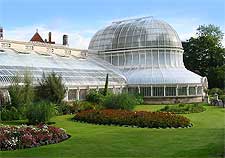
Belfast grew up around its Lough and safe river crossing. Indeed, the history of the city's name shows that it derives from 'Beal Feirste', which is Gaelic for 'the mouth of the sandy ford'.
As a settlement, Belfast is relatively young. In fact, it only really grew up from the 17th century onwards. Prior to that, there had been a castle on the site, built by John de Courcy. However, it was really only a military stronghold and was destroyed shortly afterwards.
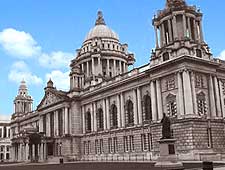
From the 17th to the 18th Century
In 1609, King James I of England started to put into action a policy whereby English and Scottish immigrants were encouraged to settle in Ulster. Belfast Castle was granted to Sir Arthur Chichester. He largely rebuilt it and a town soon grew up in its shadow. In 1613, the town was granted a charter, allowing it to be represented at the Irish House of Commons by two Members of Parliament and establishing a corporation that was partially controlled by the Chichester family, along with 12 burgesses or wealthy merchants.
From 1641 to 1649, there was the first of two major Catholic risings. In 1688, there was a second uprising against King William of Orange, which was equally unsuccessful. Following these, Belfast fell firmly under English control.
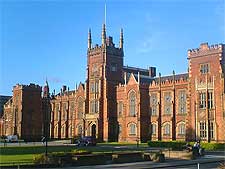
By the 18th century, Belfast had become known as Linenopolis, because of its close involvement with the linen manufacturing industry. This had prospered with the arrival of many French Protestants fleeing religious persecution. In 1777, the White Linen Hall was built. Other local industries included sail making and brewing. Boat building began here around 1791, following the formation of a Harbour Board.
The Growth of a Victorian City
In the Victorian era of history, Belfast enjoyed something of a 'golden era', with the waterfront as the engine house of its prosperity. In 1862, the Harland and Wolff Shipyard was founded. Then in 1888, Belfast was granted city status. Many of its grand buildings date back to this period of history and were aimed at demonstrating civic pride on the part of the city fathers.
Queen's University opened its doors to students in 1849. The college building was designed by renowned architect Charles Lanyon. He was also responsible for building the Custom House, in which the novelist Anthony Trollope was reputed to have kept an office. Despite this impressive building programme, conditions for many ordinary people in the city were far from ideal. In the mid-19th century, Belfast was plagued by outbreaks of cholera and typhus.
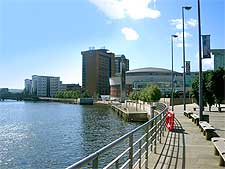
From the 20th Century to the Present
By the early 20th century, Belfast had been transformed into a major city with a population of over 450,000 people. Ship building grew up here, taking advantage of the city's deep water lough. The city specialised in large and luxury ships, including the infamous RMS Titanic, which was to sink on its maiden voyage in 1912.
During the Irish War of Independence, the city was wracked by conflict. It began in 1920 with rioting in the shipyards. In July 1921, the infamous 'Belfast Bloody Sunday' took place, in which there was fierce fighting. After the war, Belfast became the capital city of Northern Ireland. Parliament Buildings, known as the Stormont, were built to house the new administration.
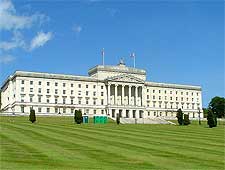
In World War Two, the city was bombed three times, destroying thousands of homes. During the post-war years, Belfast had little time in which to recover. It was beset by problems that were related to the onset of the 'Troubles'. In 1969, British troops were deployed in the city and they were to stay here for 38 years. In 1971, it experienced particularly intense fighting.
In more recent years, the city has undergone a dramatic transformation, with a number of new developments springing up all over the cityscape, including both the Belfast Waterfront Hall and the Odyssey Arena.
 Belfast grew up around its Lough and safe river crossing. Indeed, the history of the city's name shows that it derives from 'Beal Feirste', which is Gaelic for 'the mouth of the sandy ford'.
Belfast grew up around its Lough and safe river crossing. Indeed, the history of the city's name shows that it derives from 'Beal Feirste', which is Gaelic for 'the mouth of the sandy ford'.
 By the 18th century, Belfast had become known as Linenopolis, because of its close involvement with the linen manufacturing industry. This had prospered with the arrival of many French Protestants fleeing religious persecution. In 1777, the White Linen Hall was built. Other local industries included sail making and brewing. Boat building began here around 1791, following the formation of a Harbour Board.
By the 18th century, Belfast had become known as Linenopolis, because of its close involvement with the linen manufacturing industry. This had prospered with the arrival of many French Protestants fleeing religious persecution. In 1777, the White Linen Hall was built. Other local industries included sail making and brewing. Boat building began here around 1791, following the formation of a Harbour Board.
 In World War Two, the city was bombed three times, destroying thousands of homes. During the post-war years, Belfast had little time in which to recover. It was beset by problems that were related to the onset of the 'Troubles'. In 1969, British troops were deployed in the city and they were to stay here for 38 years. In 1971, it experienced particularly intense fighting.
In World War Two, the city was bombed three times, destroying thousands of homes. During the post-war years, Belfast had little time in which to recover. It was beset by problems that were related to the onset of the 'Troubles'. In 1969, British troops were deployed in the city and they were to stay here for 38 years. In 1971, it experienced particularly intense fighting.